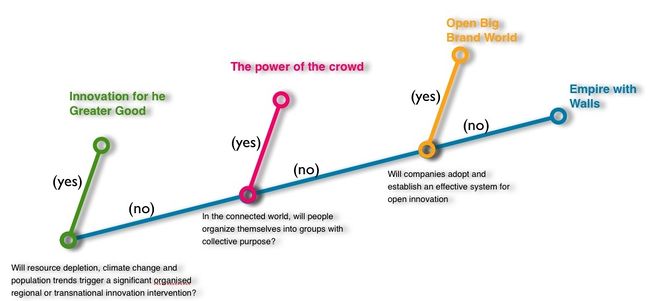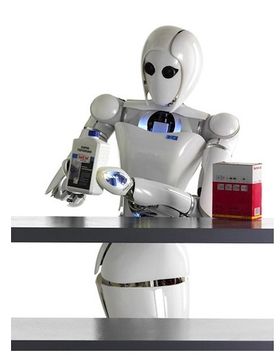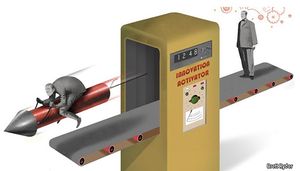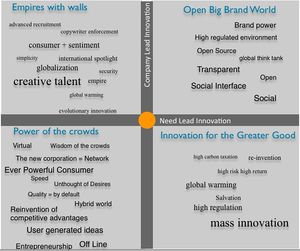Difference between revisions of "Future of Innovation Main Page"
| (116 intermediate revisions by 3 users not shown) | |||
| Line 1: | Line 1: | ||
<h2>Team Members</h2> | ---- | ||
[[Image: Female_AILA.jpg|thumb|280px]] | |||
<h2><font color="green">Team Members</font></h2> | |||
Sonal Gilani<br> | Sonal Gilani<br> | ||
Sally Henderson<br> | Sally Henderson<br> | ||
| Line 6: | Line 9: | ||
Jia Rong Wu<br> | Jia Rong Wu<br> | ||
==Focal Question | ==<font color="green">Project Overview</font>== | ||
This project is about defining how innovation 2.0 will look like. In other words what is the future of innovation. The time span we chose is 20 years from now. Therefore the scenarios are define for the year 2030.[[File:innovation.jpeg|300px|right]] The team received this challenge from Mr Russ Conser - Coordinator of the Game Changer Department from Shell.<br> | |||
If you want to know more about Mr Conser and Game Changer, please click [http://earthsky.org/energy/russ-conser-shells-gamechanger-program-sponsors-entrepreneurs] | |||
<h3><font color="#505050" >Innovation - a definition</font></h3> | |||
In 1897, James Henry Atkinson, a British inventor, came up with the notion of combining a small piece of wood, a wire spring, and a piece of cheese. He called it the "little nipper."<br><br> | |||
Procter Brothers, the Welsh company that bought the patent from Atkinson, has been fortunate that, in the 107 years since, no one has come up with a more efficient means of dispatching rodents. In fact, the company still commands 60% of the British market. For nearly every other business, though, building just one better mousetrap every century is not enough. To stay ahead, they must constantly search for the next idea that will best the competition.<br><br> | |||
Of course, successful innovation isn't simply a matter of coming up with ideas. It's the ability to nurture those ideas, make them work, and bring them to market that distinguishes a truly innovative company.<br><br> | |||
Usually, managers equate innovation with creativity. But innovation is not creativity. Creativity is about coming up with the big idea. Innovation is about executing the idea � converting the idea into a successful business. <b>Innovation</b> is: executing new ideas to create value. All three parts are important - to innovate you have to do something new, you have to actually execute the idea, and doing so must create value. <br><br> | |||
In the four scenarios we developed bellow we looked in both the idea generation part, as in the implementation part of the innovation. | |||
==<font color="green">Road Map towards the Scenarios</font>== | |||
<h3><font color="#505050" >Focal Question</font></h3> | |||
<ul> | <ul> | ||
<li>The future of Company Innovation in 2030 | <li>The future of Company Innovation in 2030 | ||
</ul> | </ul> | ||
< | <h3><font color="#505050" >Interview Questions</font></h3> | ||
[http://scenariothinking.org/wiki/index.php/Future_of_Innovation_Interview_Questions Interview Questions reference page] <br> | [http://scenariothinking.org/wiki/index.php/Future_of_Innovation_Interview_Questions Interview Questions reference page] <br> | ||
< | <h3><font color="#505050" >Research Questions</font></h3> | ||
[[Research Questions - Reference page]] | |||
<h3><font color="#505050" >Driving Forces</font></h3> | |||
[[Driving Forces - Reference Page]]<br><br> | |||
<h3><font color="#505050" >Systems Diagram</font></h3> | |||
[[Systems Diagram - Reference Page]]<br><br> | |||
<h2>Scenarios</h2> | |||
[[File:Scenario_tree_innovation.jpg|650px|]] <br><br> | |||
<b>Question 1:</b> Will resource depletion, climate change and population trends trigger a significant organized regional or transnational innovation intervention? <br> | |||
Yes - Innovation for he Greater Good (Scenario 1) <br>[[File:Innovation_scenarios.jpg|300px|right]] | |||
<b>Question 2</b> In the connected world, will people organise themselves into groups with collective purpose? (yes/no) <br> | |||
Yes - The power of the crowds (Scenario 2) <br> | |||
<b>Question 3</b> Will companies adopt and establish an effective system for open innovation? <br> | |||
Yes - Open Big Brand World (Scenario 3)<br> | |||
No - Empire with Walls (Scenario 4)<br> | |||
<h3><font color="#505050" >Scenario Stories</font></h3> | |||
[[Scenario 1 - Innovation for the Greater Good]]<br> | |||
1 | Highlights: Collaborative Innovation, Government participation, Enviornmental Regulations, Sustainability, High Investment | ||
[[Scenario 2 - The Power of Crowds]] <br> | |||
Highlights: Standardization, Simplicity, Aggregation, Speed, Hyper-connectivity | |||
2 | [[Scenario 3 - Open Big Brand World]] <br> | ||
Highlights: Brand leverage, Social platforms, Company lead, Low risk, Open innovation | |||
[[Scenario 4 - Empire with Walls]] <br> | |||
Highlights: Protectionism, Intellectual security, Effective Globalization, High Risk, Environmental compliance<br><br> | |||
After your read our scenarios, we would love to hear your feedback. Therefore, please feel free to write us at aursu(at)rsm11.mba.nl, sgilani(at)mba11.rsm.nl, esaliu-lawal(at)mba11.rsm.nl, jiwu(at)mba11.rsm.nl or shenderson(at)mba11.rsm.nl. | |||
- | <h2><font color="green">Further Reading</font></h2> | ||
<h3><font color="#505050" > Web Source</font></h3> | |||
* JSB at Stanford: "Collaborative Innovation and a Pull Economy" [http://edgeperspectives.com/blog/2010/04/jsb-at-stanford-collaborative-innovation-and-a-pull-economy.html] <br> | |||
* JSB web page [ http://www.johnseelybrown.com] <br> | |||
* Using knowledge brokering to improve business processes [https://www.mckinseyquarterly.com/Using_knowledge_brokering_to_improve_business_processes_2512] <br> | |||
* Are you fostering innovation in your organization? - a PWC report [http://www.pwc.com/us/en/view/fall09/fostering-innovation.jhtml]<br> | |||
* Government's many roles in fostering innovation - a PWC report [http://www.pwc.com/gx/en/technology/publications/governments-role-in-fostering-innovation.jhtml] | |||
* Why innovate? - a Tourism Excellence Article [http://www.tourismexcellence.com.au/Fostering-Innovation/Why-Innovate.html]<br> | |||
* Reasons for Open Innovation Failure [http://www.innovationmanagement.se/2010/08/10/top-10-reasons-for-open-innovation-failure/]<br> | |||
* Open Innovation in EU [http://www.openinnovation.eu]<br> | |||
<h3><font color="#505050" >Further Innovation Reading</font> </h3> | |||
< | * The innovation machine - Two gurus look at the perspiration side of innovation [http://www.economist.com/node/16888745] | ||
* Innovation is Not Creativity [http://blogs.hbr.org/govindarajan/2010/08/innovation-is-not-creativity.html] | |||
- the | * Innovation and commercialization, 2010: McKinsey Global Survey results [https://www.mckinseyquarterly.com/Strategy/Innovation] | ||
- | * 2010 Innovation Insanity - a Trend Watching briefing report [http://trendwatching.com/trends/innovationinsanity/] | ||
* The ergonomics of innovation - [https://www.mckinseyquarterly.com/Strategy/Innovation/The_ergonomics_of_innovation_2197] | |||
* Succeeding at open-source innovation: An interview with Mozilla�s Mitchell Baker [https://www.mckinseyquarterly.com/Strategy/Innovation/Succeeding_at_open-source_innovation__An_interview_with_Mozillas_Mitchell_Baker_2098] | |||
- | * Leadership and innovation report 2008 [http://www.strategyexecution.in/yahoo_site_admin/assets/docs/Innovation__Execution.513527.pdf] | ||
* TSMC�s Open Innovation Platform [http://blogs.ft.com/techblog/2009/06/tsmcs-open-innovation-platform/] | |||
* MIT's Eric von Hippel: Open Innovation & LEGO Mindstorms [http://fora.tv/2008/04/08/MITs_Eric_von_Hippel_Open_Innovation] | |||
- | |||
<h3><font color="#505050" >Further Reading - Books</font></h3> | |||
* Wisdom of Crowds [http://www.amazon.com/Wisdom-Crowds-James-Surowiecki/dp/0385721706/ref=sr_1_1?s=books&ie=UTF8&qid=1282919569&sr=1-1] | |||
* The Big Switch [http://www.amazon.com/Big-Switch-Rewiring-Edison-Google/dp/0393333949/ref=sr_1_1?s=books&ie=UTF8&qid=1282919539&sr=1-1] | |||
* The Long Tail [http://www.amazon.com/Long-Tail-Revised-Updated-Business/dp/B001PTG4BO/ref=sr_1_1?s=books&ie=UTF8&qid=1282919502&sr=1-1] | |||
* Swarm Creativity: Competitive Advantage through Collaborative Innovation Networks [http://www.amazon.com/Swarm-Creativity-Competitive-Collaborative-Innovation/dp/0195304128/ref=sid_dp_dp/186-7899695-2573164#reader_0195304128] | |||
<h3><font color="#505050" >Want to know even more about scenarios? </font></h3> | |||
The Evolving Internet: A look ahead to 2025 by Cisco and the Monitor Group's Global Business Network [http://newsroom.cisco.com/dlls/2010/prod_082510b.html]<br> | |||
Scenario Panning Resources from futuramb.se [http://www.well.com/~mb/scenario_planning/] | |||
<br> | <br> | ||
<h2> | <h2><font color="green">Numbers that matter</font></h2> | ||
[[Number that matter reference page]] | |||
<h2><font color="green">Key Group Learnings</font></h2> | |||
* Iteration within the groups, helps deepen the scenario, adding quality, surprise and plausibility. On top of it, Following expert's opinions (in our case reading JSB's work was extremely mind opening) and not omitting current trends, build up on the scenario's plausibility | |||
* The process of building scenarios prepares you for foundation of learning or accepting new ideas - readying you for serendipitous ideas and encounters. <br> | |||
* Different members researching different areas - offers more perspectives for the same issue - making, at least in our experience, more surprising. On top of this, it ads to the surprising part of the scenarios, having in the team people with different backgrounds.<br> | |||
* Technical preparation of the presentation is as vital as working on the presentation itself :-) | |||
[[RSM MBA 2010 Scenarios]] | |||
Latest revision as of 23:15, 1 November 2021
Team Members
Sonal Gilani
Sally Henderson
Eghe Saliu-Lawal
Alexandra Ursu
Jia Rong Wu
Project Overview
This project is about defining how innovation 2.0 will look like. In other words what is the future of innovation. The time span we chose is 20 years from now. Therefore the scenarios are define for the year 2030.
The team received this challenge from Mr Russ Conser - Coordinator of the Game Changer Department from Shell.
If you want to know more about Mr Conser and Game Changer, please click [1]
Innovation - a definition
In 1897, James Henry Atkinson, a British inventor, came up with the notion of combining a small piece of wood, a wire spring, and a piece of cheese. He called it the "little nipper."
Procter Brothers, the Welsh company that bought the patent from Atkinson, has been fortunate that, in the 107 years since, no one has come up with a more efficient means of dispatching rodents. In fact, the company still commands 60% of the British market. For nearly every other business, though, building just one better mousetrap every century is not enough. To stay ahead, they must constantly search for the next idea that will best the competition.
Of course, successful innovation isn't simply a matter of coming up with ideas. It's the ability to nurture those ideas, make them work, and bring them to market that distinguishes a truly innovative company.
Usually, managers equate innovation with creativity. But innovation is not creativity. Creativity is about coming up with the big idea. Innovation is about executing the idea � converting the idea into a successful business. Innovation is: executing new ideas to create value. All three parts are important - to innovate you have to do something new, you have to actually execute the idea, and doing so must create value.
In the four scenarios we developed bellow we looked in both the idea generation part, as in the implementation part of the innovation.
Road Map towards the Scenarios
Focal Question
- The future of Company Innovation in 2030
Interview Questions
Interview Questions reference page
Research Questions
Research Questions - Reference page
Driving Forces
Driving Forces - Reference Page
Systems Diagram
Systems Diagram - Reference Page
Scenarios

Question 1: Will resource depletion, climate change and population trends trigger a significant organized regional or transnational innovation intervention?
Yes - Innovation for he Greater Good (Scenario 1)
Question 2 In the connected world, will people organise themselves into groups with collective purpose? (yes/no)
Yes - The power of the crowds (Scenario 2)
Question 3 Will companies adopt and establish an effective system for open innovation?
Yes - Open Big Brand World (Scenario 3)
No - Empire with Walls (Scenario 4)
Scenario Stories
Scenario 1 - Innovation for the Greater Good
Highlights: Collaborative Innovation, Government participation, Enviornmental Regulations, Sustainability, High Investment
Scenario 2 - The Power of Crowds
Highlights: Standardization, Simplicity, Aggregation, Speed, Hyper-connectivity
Scenario 3 - Open Big Brand World
Highlights: Brand leverage, Social platforms, Company lead, Low risk, Open innovation
Scenario 4 - Empire with Walls
Highlights: Protectionism, Intellectual security, Effective Globalization, High Risk, Environmental compliance
After your read our scenarios, we would love to hear your feedback. Therefore, please feel free to write us at aursu(at)rsm11.mba.nl, sgilani(at)mba11.rsm.nl, esaliu-lawal(at)mba11.rsm.nl, jiwu(at)mba11.rsm.nl or shenderson(at)mba11.rsm.nl.
Further Reading
Web Source
- JSB at Stanford: "Collaborative Innovation and a Pull Economy" [2]
- JSB web page [ http://www.johnseelybrown.com]
- Using knowledge brokering to improve business processes [3]
- Are you fostering innovation in your organization? - a PWC report [4]
- Government's many roles in fostering innovation - a PWC report [5]
- Why innovate? - a Tourism Excellence Article [6]
- Reasons for Open Innovation Failure [7]
- Open Innovation in EU [8]
Further Innovation Reading
- The innovation machine - Two gurus look at the perspiration side of innovation [9]
- Innovation is Not Creativity [10]
- Innovation and commercialization, 2010: McKinsey Global Survey results [11]
- 2010 Innovation Insanity - a Trend Watching briefing report [12]
- The ergonomics of innovation - [13]
- Succeeding at open-source innovation: An interview with Mozilla�s Mitchell Baker [14]
- Leadership and innovation report 2008 [15]
- TSMC�s Open Innovation Platform [16]
- MIT's Eric von Hippel: Open Innovation & LEGO Mindstorms [17]
Further Reading - Books
- Wisdom of Crowds [18]
- The Big Switch [19]
- The Long Tail [20]
- Swarm Creativity: Competitive Advantage through Collaborative Innovation Networks [21]
Want to know even more about scenarios?
The Evolving Internet: A look ahead to 2025 by Cisco and the Monitor Group's Global Business Network [22]
Scenario Panning Resources from futuramb.se [23]
Numbers that matter
Number that matter reference page
Key Group Learnings
- Iteration within the groups, helps deepen the scenario, adding quality, surprise and plausibility. On top of it, Following expert's opinions (in our case reading JSB's work was extremely mind opening) and not omitting current trends, build up on the scenario's plausibility
- The process of building scenarios prepares you for foundation of learning or accepting new ideas - readying you for serendipitous ideas and encounters.
- Different members researching different areas - offers more perspectives for the same issue - making, at least in our experience, more surprising. On top of this, it ads to the surprising part of the scenarios, having in the team people with different backgrounds.
- Technical preparation of the presentation is as vital as working on the presentation itself :-)


